Origin of Mandibular Nerve
Mandibular nerve is the largest of the three divisions of trigeminal nerve
- It is a mixed nerve containing both sensory and motor fibers.
- It is the nerve of 1st pharyngeal arch and supplies all structures derived from this arch.
Origin:
- It begins in the middle cranial fossa.
- It is formed by two roots – a large sensory and smaller motor root.
- The sensory root arises from trigeminal ganglion and the motor root is attached to the ventral aspect of pons and passes below the trigeminal ganglion.
Course of Mandibular Nerve
Course:
- Both the roots pass through the foramen ovale to infratemporal fossa.
- The two roots join to form the trunk of manibular nerve.
- After a very short course in the infratemporal fossa, the trunk divides into:
- Anterior division (mainly motor)
- Posterior division (mainly sensory)
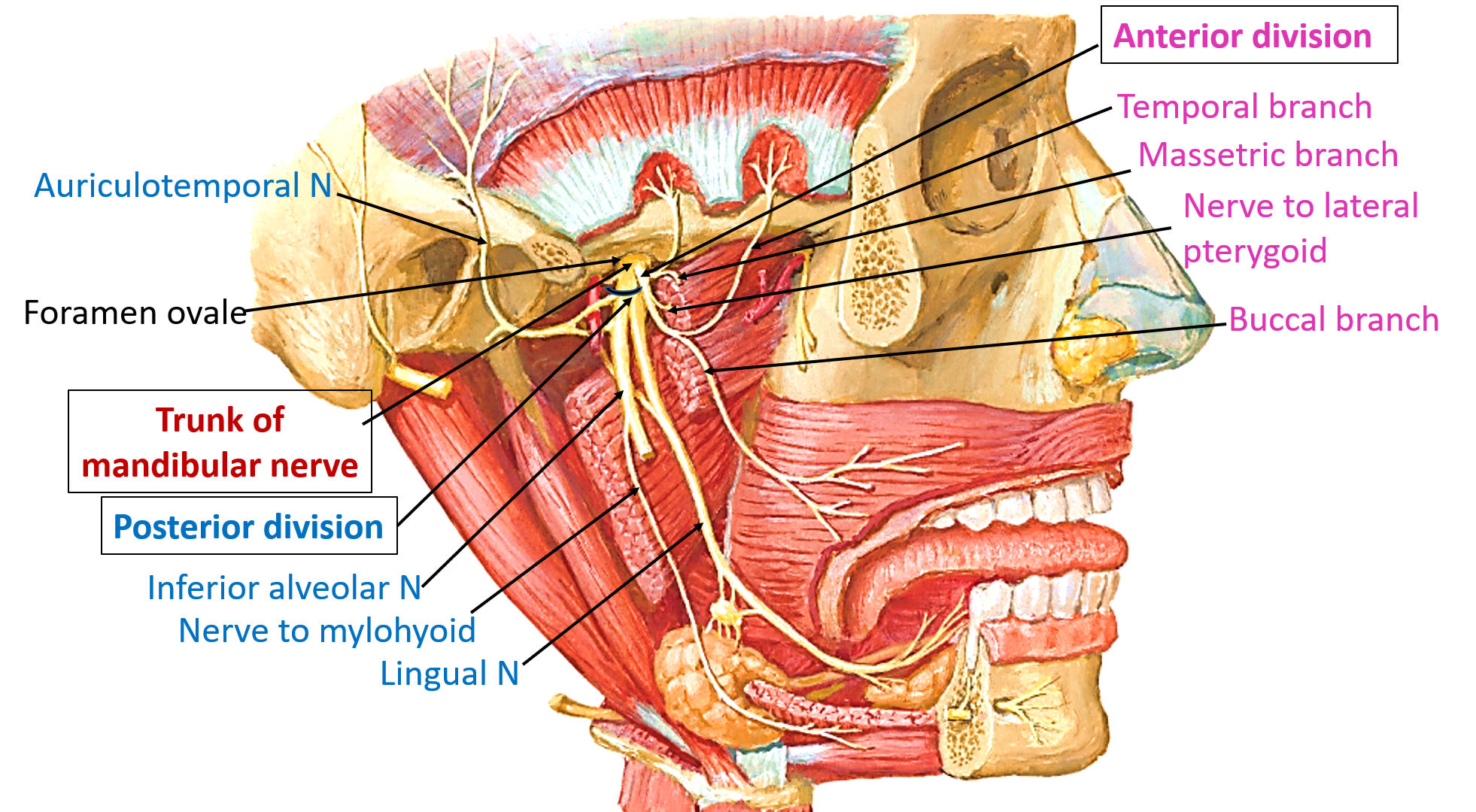
Relations of the trunk of mandibular nerve:
- Anteriorly is the otic ganglion.
- Posteriorly is middle meningeal artery.
- Medially is tensor veli palatini muscle.
- Laterally is lateral pterygoid muscle.
Branches of Mandibular Nerve and Its Distribution
From the trunk
- Meningeal branch (sensory): It supplies duramater of middle cranial fossa.
- Nerve to medial pterygoid (motor): It supplies 3 muscles (medial pterygoid, tensor veli palatini and tensor tympani)
From the anterior division
Anterior division is mainly motor and supplies all the muscles of mastication except medial pterygoid. The branches are:
- Motor branches
- Massetric: It supplies masseter muscle and temporomandibular joint.
- Deep temporal nerves (two): They supply temporalis muscle.
- Nerve to lateral pterygoid: It supplies lateral pterygoid muscle.
- Sensory branch
- Buccal branch supplies skin and mucus membrane of cheek.
From the posterior division
Posterior division is mainly sensory.
- Sensory branches
- Auriculotemporal nerve: It supplies the skin of temple, lateral surface of auricle, external auditory meatus, outer surface of tympanic membrane, temporomandibular joint, parotid gland.
- Lingual nerve: It supplies anterior 2/3rd of tongue (general sensations), floor of mouth, lingual surface of gums of lower jaw, submandibular and sublingual glands.
- Inferior alveolar nerve: is mixed nerve.
- Sensory branches to lower teeth, skin of chin and skin and mucous membrane of lower lip.
- Motor branches are nerve to mylohyoid supplies anterior belly of digastric and mylohyoid muscles.
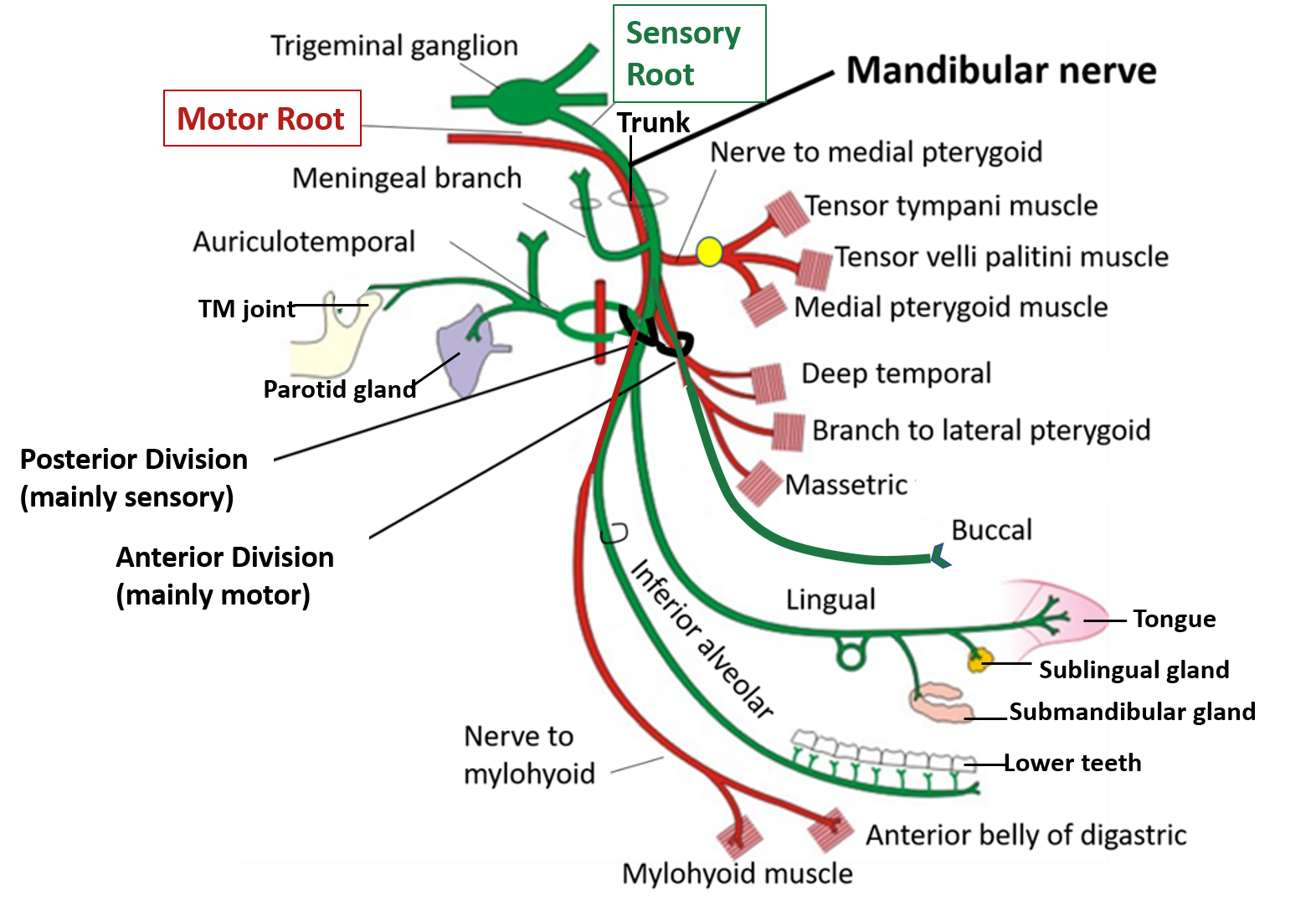
Describe the Course and Branches of Auriculotemporal Nerve.
Auriculotemporal nerve:
- It is a sensory nerve and arises as two roots from the posterior division of mandibular nerve, which encircle the middle meningeal artery and unite to form a single trunk.
- It runs backward around the neck of mandible to reach behind the temporomandibular joint.It then turns upward, crosses posterior root of zygoma and gives terminal branches in the region of temporal fossa.
Branches: Its branches are:
- Auricular: Supply the skin of upper 1/3rd of lateral surface of auricle, external acoustic meatus and adjoining tympanic membrane.
- Articular: Supply temporo-mandibular joint.
- Superficial temporal: supply the skin over posterior part of temple.
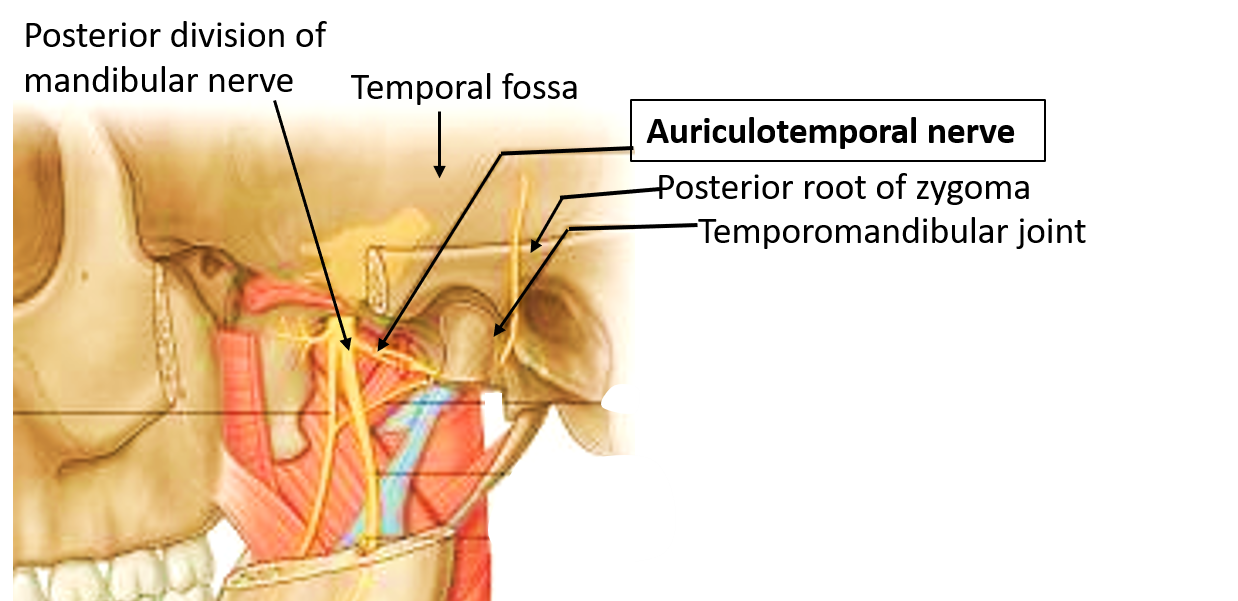
Describe the Course and Branches of inferior Alveolar Nerve.
Inferior Alveolar nerve:
- It is a mixed nerve that is the larger of the tow terminal branches of posterior division of mandibular nerve.
- It runs downwards deep to the lateral pterygoid muscle. It then emerges below the lower border of lateral pterygoid muscle and runs on the medial pterygoid muscle further downwards to enter the mandibular foramen present on the inner aspect of ramus of mandible.
- It traverses the mandibular canal and divides into terminal branches below the level of premolars.
Branches:
- Nerve to mylohyoid: It arises before the mandibular nerve enters the mandibular foramen. It pierces the sphenomandibular ligament and supplies mylohyoid and anterior belly of digastric muscles.
- Inferior dental plexus: Few fibers form a plexus before supplying the lower molars and premolars.
- Incisive branch: it supplies lower canine and incisor teeth.
- Mental branch: It supplies the skin of chin and lower lip.
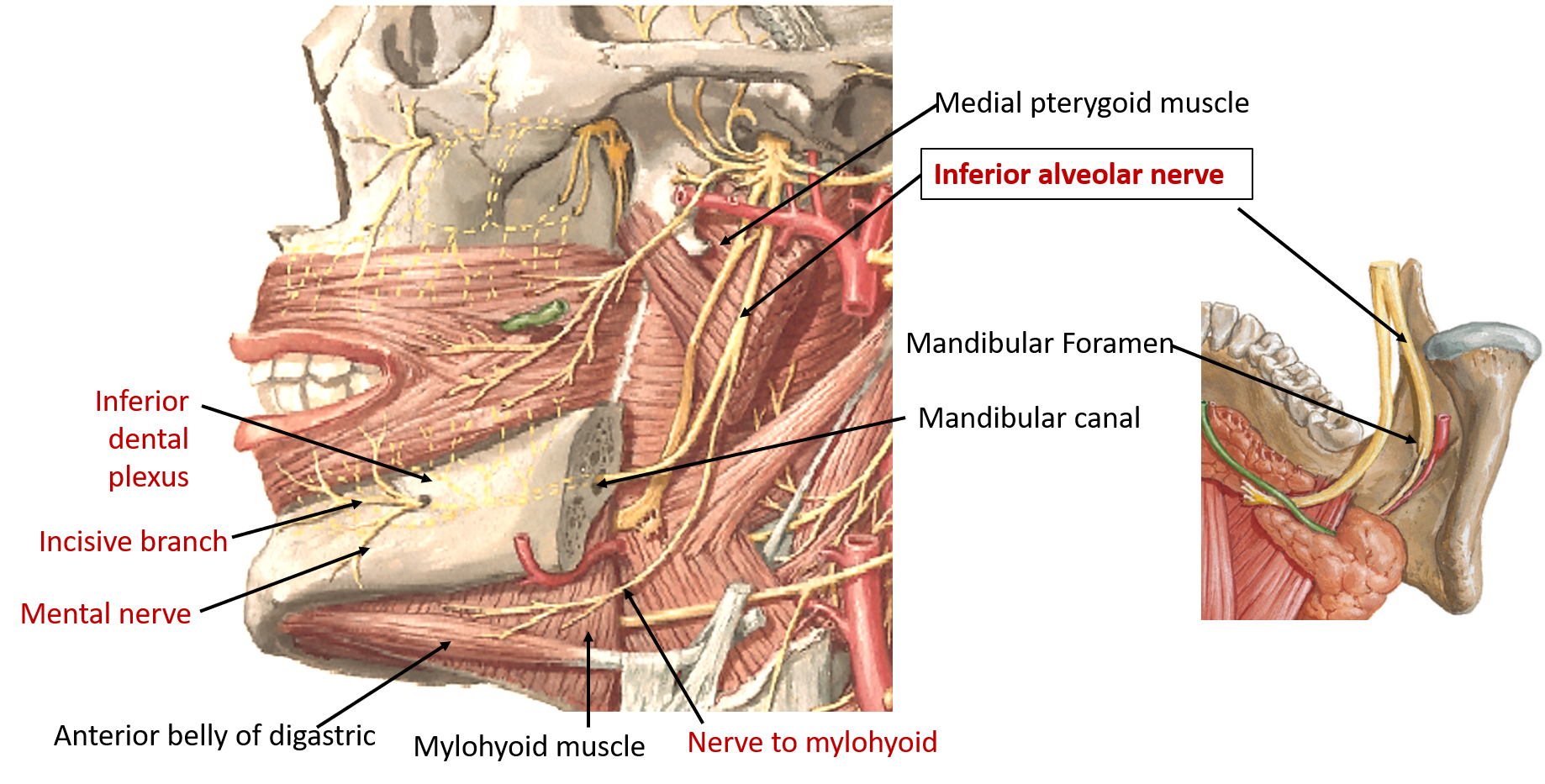
Describe the Course and Branches of Lingual Nerve.
Lingual nerve:
- It is a sensory nerve that arises from the posterior division of mandibular nerve.
- In the infratemporal fossa 2cm below the base of skull, it is joined by chorda tympani nerve (branch of facial nerve) which carries secretomotor fibers to the submandibular and sublinual glands and taste sensation from the anterior 2/3rd of tongue.
- It runs downwards deep to the lateral pterygoid muscle and then between the medial pterygoid and ramus of mandible. It then passes forward between the attachment of superior constrictor of pharynx and mylohyoid muscle, and little below the last molar tooth.
- It continues the forward course superficial to the hyoglossus muscle (here, the submandibular ganglion is suspended from the lingual nerve).
- It finally curves under the submandibular duct and turns up medially towards the anterior part of tongue and floor of mouth.
Branches: It provides sensory branches to the anterior 2/3rd of the tongue, floor of mouth and adjoining area of gums.
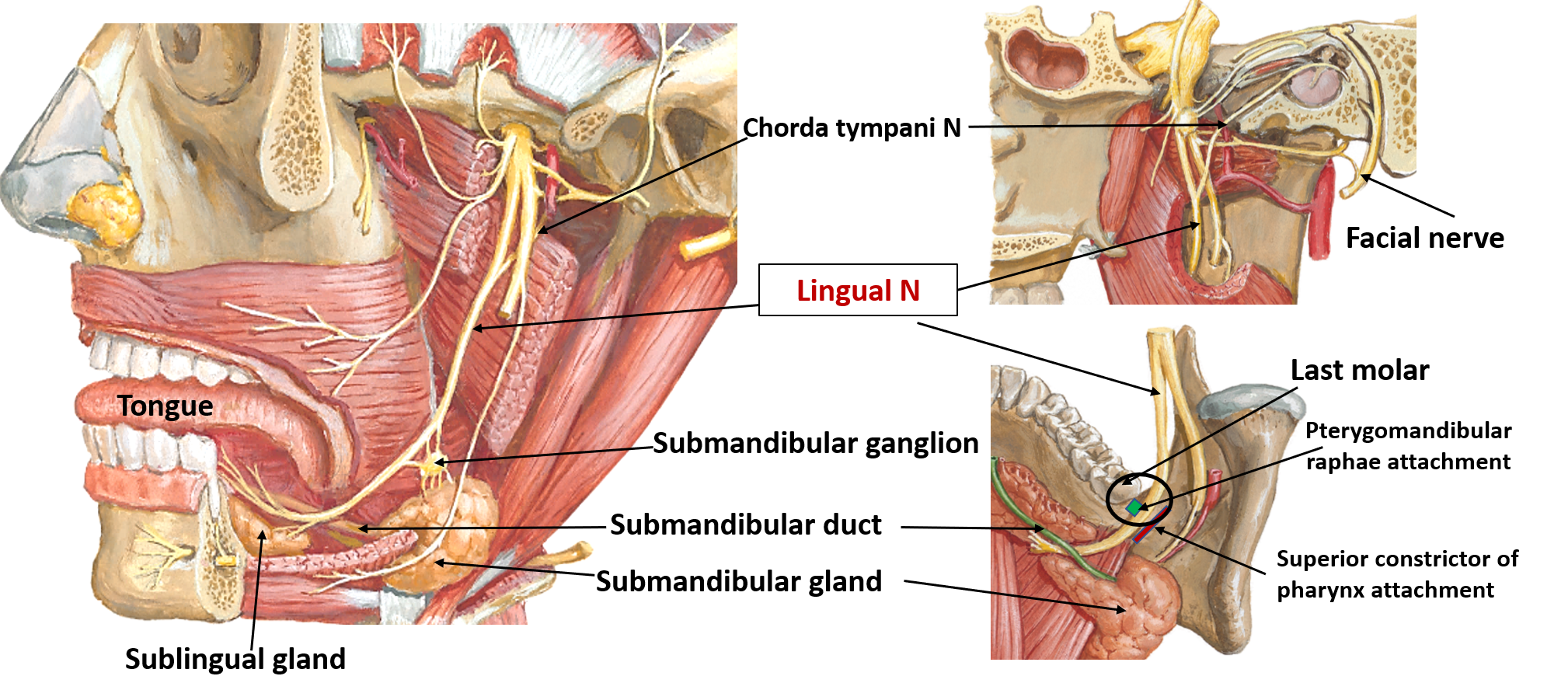
Applied Aspects
Pain from an infected lower tooth may be referred to the ear.
It is because both are supplied by branches of mandibular nerve.For the same reason, in cases of cancer of tongue pain radiates to ear.
Lingual nerve may get injured during extraction of lower last molar tooth.
This may occur because the lingual nerve is closely related to the mandible below and medial to the last molar tooth.
Inferior alveolar nerve block.
When the mouth is opened wide, a mucosal fold can be seen at the posterior aspect of inside of cheek. this fold overlies the pterygomandibular raphe, which can be felt as a firm band running upwards from just behind the lower third molar tooth. The upper end of the raphe is an important landmark for inferior alveolar nerve block.

Do u please suggest any link for physiology and biochemistry pls
This is just wawooo, 💪 u did it best